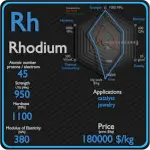This article contains comparison of key thermal and atomic properties of palladium and platinum, two comparable chemical elements from the periodic table. It also contains basic descriptions and applications of both elements. Palladium vs Platinum.

Palladium and Platinum – About Elements


Source: www.luciteria.com
Palladium and Platinum – Applications
Palladium
More than half the supply of palladium and its congener platinum is used in catalytic converters, which convert as much as 90% of the harmful gases in automobile exhaust into less noxious substances. Palladium is also used in electronics, dentistry, medicine, hydrogen purification, chemical applications, groundwater treatment, and jewelry. Palladium-based alloys are being extensively used in fuel cell technology applications. The metal is also employed in historic photographic printing process. Palladium has been used as a precious metal in jewelry since 1939 as an alternative to platinum in the alloys called “white gold”.
Platinum
Platinum is primarily an industrial metal. It is a critical material for many industries and is considered a strategic metal. Platinum is used as a catalyst, platinum is mostly found in vehicle catalytic converters that reduce toxic exhaust chemicals, and also in fuel cells to increase efficiency. The most common use of platinum is as a catalyst in chemical reactions, often as platinum black. In catalytic converters, platinum allows the complete combustion of low concentrations of unburned hydrocarbons from the exhaust into carbon dioxide and water vapor. Platinum has been used in thermocouple devices that measure temperature with high accuracy. Platinum is a component in magnetic coatings for high-density hard disk drives and some of the newer optical storage systems.
Palladium and Platinum – Comparison in Table
| Element | Palladium | Platinum |
| Density | 12.023 g/cm3 | 21.09 g/cm3 |
| Ultimate Tensile Strength | 135 MPa | 150 MPa |
| Yield Strength | 30 MPa | 70 MPa |
| Young’s Modulus of Elasticity | 121 GPa | 168 GPa |
| Mohs Scale | 4.8 | 3.5 |
| Brinell Hardness | 320 MPa | 400 MPa |
| Vickers Hardness | 400 MPa | 550 MPa |
| Melting Point | 1554.9 °C | 1772 °C |
| Boiling Point | 2963 °C | 3827 °C |
| Thermal Conductivity | 72 W/mK | 72 W/mK |
| Thermal Expansion Coefficient | 11.8 µm/mK | 8.8 µm/mK |
| Specific Heat | 0.24 J/g K | 0.13 J/g K |
| Heat of Fusion | 17.6 kJ/mol | 19.6 kJ/mol |
| Heat of Vaporization | 357 kJ/mol | 510 kJ/mol |







